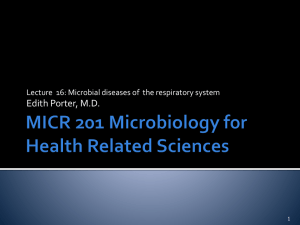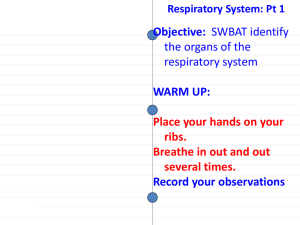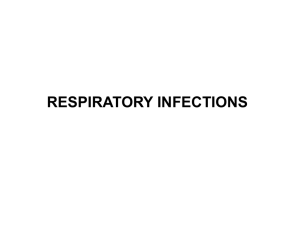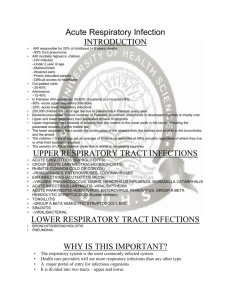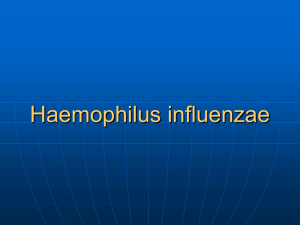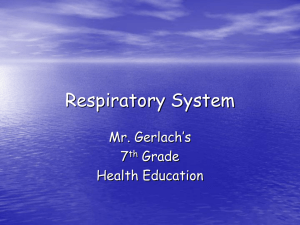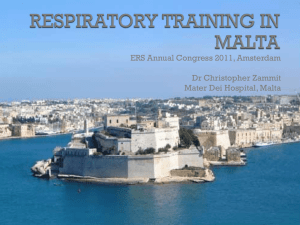Chapter 20: Infectious Diseases Affecting the Respiratory Tract
advertisement
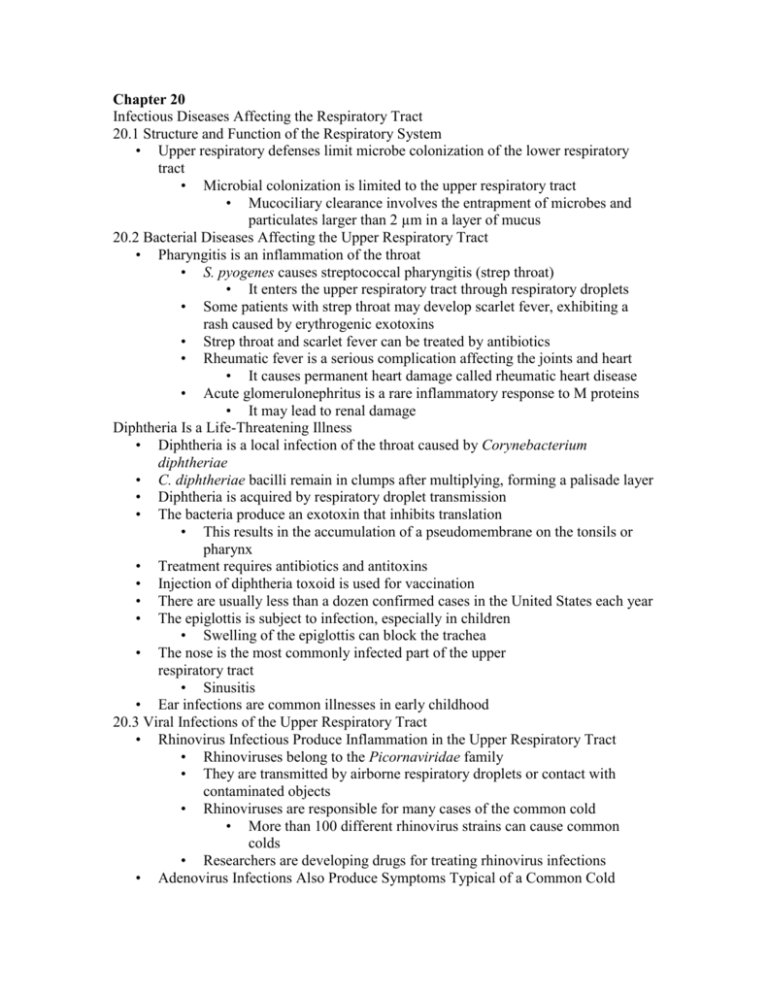
Chapter 20 Infectious Diseases Affecting the Respiratory Tract 20.1 Structure and Function of the Respiratory System • Upper respiratory defenses limit microbe colonization of the lower respiratory tract • Microbial colonization is limited to the upper respiratory tract • Mucociliary clearance involves the entrapment of microbes and particulates larger than 2 µm in a layer of mucus 20.2 Bacterial Diseases Affecting the Upper Respiratory Tract • Pharyngitis is an inflammation of the throat • S. pyogenes causes streptococcal pharyngitis (strep throat) • It enters the upper respiratory tract through respiratory droplets • Some patients with strep throat may develop scarlet fever, exhibiting a rash caused by erythrogenic exotoxins • Strep throat and scarlet fever can be treated by antibiotics • Rheumatic fever is a serious complication affecting the joints and heart • It causes permanent heart damage called rheumatic heart disease • Acute glomerulonephritus is a rare inflammatory response to M proteins • It may lead to renal damage Diphtheria Is a Life-Threatening Illness • Diphtheria is a local infection of the throat caused by Corynebacterium diphtheriae • C. diphtheriae bacilli remain in clumps after multiplying, forming a palisade layer • Diphtheria is acquired by respiratory droplet transmission • The bacteria produce an exotoxin that inhibits translation • This results in the accumulation of a pseudomembrane on the tonsils or pharynx • Treatment requires antibiotics and antitoxins • Injection of diphtheria toxoid is used for vaccination • There are usually less than a dozen confirmed cases in the United States each year • The epiglottis is subject to infection, especially in children • Swelling of the epiglottis can block the trachea • The nose is the most commonly infected part of the upper respiratory tract • Sinusitis • Ear infections are common illnesses in early childhood 20.3 Viral Infections of the Upper Respiratory Tract • Rhinovirus Infectious Produce Inflammation in the Upper Respiratory Tract • Rhinoviruses belong to the Picornaviridae family • They are transmitted by airborne respiratory droplets or contact with contaminated objects • Rhinoviruses are responsible for many cases of the common cold • More than 100 different rhinovirus strains can cause common colds • Researchers are developing drugs for treating rhinovirus infections • Adenovirus Infections Also Produce Symptoms Typical of a Common Cold • • Adenoviruses belong to family Adenoviridae They induce the formation of inclusion bodies in host tissues • Adenoviruses are transmitted through respiratory droplets • Infection can cause • acute febrile pharyngitis • pharyngoconjuntival fever • acute respiratory disease • Any of these can progress to viral pneumonia 20.4 Diseases of the Lower Respiratory Tract • Pertussis (Whooping Cough) is Highly Contagious • Bordatella pertussis is spread by respiratory droplet transmission • Toxin paralyzes ciliated cells in the respiratory tract • Patients experience multiple paroxysms of coughs, followed by an inhalation of breath that sounds like a “whoop” • Erythromycin reduces the duration and severity of illness • The newer vaccine contains B. pertussis chemical extracts rather than killed cells • The number of cases in the United States has been rising since 1981 Tuberculosis Is a Major Cause of Death Worldwide • 2 million people die of TB every year, globally • Mycobacterium tuberculosis enters the respiratory tract in small aerosolized droplets • About 90% of people who carry latent tuberculosis will never develop an active infection • They may never even know they are infected • Clinical TB develops within 3 months and can be transmitted to others • Sputum coughed from the lower respiratory tract may contain blood • Macrophages accumulate in the lung • They form a tubercle that harbors M. tuberculosis • If a tubercle breaks apart, bacteria spread throughout the body • Miliary tuberculosis is the development of active tubercles throughout the body • The tuberculin reaction in the Mantoux test can be used for early detection of TB exposure • Multidrug-resistance Mycobacterium tuberculosis is affecting which antibiotics are used to treat TB • TB is a particularly big problem for AIDS patients • Attenuated M. bovis is used in immunization • Infectious bronchitis is an inflammation of the bronchi • Bronchitis produces excessive mucus and a narrowing of the bronchi “Typical” Pneumonia Can Be Caused by Several Bacteria • 80% of “typical” pneumonia cases are caused by Streptococcus pneumoniae • It is acquired through aerosolized droplets or contact • Pneumococcal pneumonia can involve • an entire lung lobe (lobar pneumonia) • both lungs (double pneumonia) • or patches in the respiratory passageways (bronchopneumonia) • Haemophilus influenzae can cause • “typical” pneumonia • otitis media sinusitis • Staphylococcus aureus is a common hospital-acquired form of pneumonia • It may result in necrotizing pneumonia • Klebsiella pneumoniae can be a primary or secondary infection in people with impaired pulmonary function “Atypical” Pneumonia Can Be Caused by a Diverse Group of Bacterial Species • Mycoplasma pneumoniae causes primary atypical pneumonia, often called walking pneumonia • M. pneumoniae has no sensitivity to penicillin because it has no cell wall • The cold agglutinin screening test (CAST) is used to assist diagnosis Legionella pneumophila causes Legionnaires’ disease • It lives where water collects and becomes airborne in the wind (or ventilation system) • Disease develops within a week of inhalation of contaminated droplets • Necrotizing pneumoniamay develop • L. pneumophila also causes Pontiac fever, an influenza-like infection Some Rickettsiae and Chlamydiae Also Cause Pneumonia • Coxiella burnetii causes Q fever, a prevalent disease of livestock • Humans can acquire the disease by consuming contaminated raw or improperly pasteurized milk • Chlamydia psittaci causes psittacosis (a.k.a. ornithosis) • It is a zoonotic disease humans can catch from infected birds • Chlamydia pneumoniae causes chlamydial pneumonia • Inhalational anthrax is an occupational hazard • Bacillus anthracis spores can be inhaled in contaminated dust • Woolsorter’s disease • Bioterrorism threat 20.5 Viral Infections of the Lower Respiratory Tract • Influenza Is a Highly Communicable Acute Respiratory Infection • It is transmitted by airborne respiratory droplets • There have been at least 31 influenza pandemics since 1510 • The virion belongs to the Orthomyxoviridae family • It contains two types of spikes • Hemagglutin (H) helps the virion attach and penetrate host cells • Neuraminidase (N) helps release virions from the host cell after replication and assembly • Influenza A strikes every year and causes most epidemics • Influenza B also strikes every year but is less common than type A • • Influenza C causes a mild respiratory illness but not epidemics A new flu strain evolves every year, requiring development of a new vaccine • Complications such as pneumonia or secondary infections occur in • Infants • Elderly • Immunocompromised people • Guillain-Barré syndrome occurs when the body damages its own peripheral nerve cells • Reye syndrome often occurs in children who take aspirin to treat pain and fever • Paramyxovirus Infections Affect the Lower Respiratory Tract • Respiratory syncytial (RS) disease is caused by the respiratory syncytial virus (RSV) • It commonly affects children under 1 year of age • It infects the bronchials and alveoli of the lungs, causing cells to fuse together into syncytia • Parainfluenza infections are usually caused by human parainfluenza viruses 1 and 3 • Infections are milder than influenza • Human metapneumovirus (hMPV) are RSV-like viruses • Symtoms are milder than RS disease Other viruses also produce pneumonia • Severe Acute Respiratory Syndrome (SARS) Spreads through Close Person-toPerson Contact • SARS is an emerging infectious disease of the family Coronaviridae • It is spread by contact with an infected person or an object upon which they have coughed or sneezed • Bats may be the natural host of the virus • A moderate upper respiratory illness may develop into severe respiratory illness and pneumonia • All SARS patients should be isolated for at least 10 days after fever has broken to prevent spread • Hantavirus pulmonary syndrome (HPS) occurs in the southwestern United States • It is caused by a strain of hantavirus named “Sin Nombre” • The deer mouse is the host, shedding the virus in saliva, urine, and feces • Humans become infected with hantavirus by inhaling dried, aerosolized urine or feces • Many patients suffer from • headaches • dizziness • difficulty breathing • low blood pressure • Respiratory failure can occur as the lungs fill with fluid 20.6 Fungal Diseases Affecting the Lower Respiratory Tract • Histoplasmosis Can Produce a Systemic Disease • It is caused by Histoplasma capsulatum • It is found in dry, dusty soil, chicken coops, and bat caves • Most people suffer only mild influenza-like symptoms • Blastomycosis Usually Is Acquired Via the Respiratory Route • It is caused by Blastomyces dermatitidis • It is associated with dusty soil and bird droppings • Inhalation causes • lung lesions • persistent cough • chest pains • It can cause chronic pneumonia and may disseminate to other organs in AIDS patients • Coccidioidomycosis Can Become a Potentially Lethal Infection • It is caused by Coccidioides immitis • Inhalation of spores causing • a dry, hacking cough • chest pains • high fever • Rarely, infection disseminates to tissues such as meninges of the spinal cord • Opportunistic mycoses affect immunocompromised individuals • Cryptococcosis usually occurs in immunocompromised individuals • It is caused by Cryptococcus neoformans • C. neoformans is found in urban soil and pigeon droppings • Inhaled cells penetrate to the air sacs of lungs • Cells can (rarely) pass into the bloodstream, infecting the brain and meninges Pneumocystis Pneumonia Can Cause a Lethal Pneumonia • It is caused by Pneumocystis jiroveci • It is a common infection in AIDS patients • P. jiroveci has a complex life cycle in the alveoli • It is usually transmitted through respiratory droplets Other Fungi Also Cause Mycoses • In aspergillosis, conidia enter the body and grow as a mycelium • It is commonly caused by Aspergillus fumigatus • Surgery may be necessary to remove an aspergilloma from the lungs • Fungal toxins are called mycotoxins • A. flavus and A. parasiticus produce carcinogenic aflatoxins • Aflatoxins contaminate many agricultural products

